Omori Ryu: The Foundation of Muso Shinden Ryu Iaido
By Deborah Klens-Bigman, Ph.D.
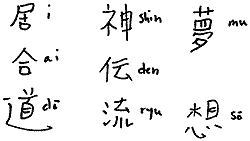
Editor's Note: This is the third in a continuing
series of articles on the Japanese art of iaido the modern discipline
or way of drawing the sword that assumed its present form in the early
20th century. The series started with “The
Study Of Iaido” followed by “Layers
Of Shu-Ha-Ri In The Practice Of Iaido.” This article focuses
on the curriculum of Muso Shinden ryu iaido, the style of sword drawing
that the author teaches. Future articles will discuss other physical and
aesthetic concepts of iaido in context of actual practice.
Historic Background
Very briefly put, Muso Shinden ryu iaido (MSR) is one of the many styles
of drawing the Japanese sword descended from Hayashizaki Jinsuke Shigenobu.
As I have pointed out elsewhere on the website, Hayashizaki is considered
the "founder" of sword drawing as a form distinct from fighting
with swords already drawn. MSR iaido descended by way of Tamiya ryu
iaijutsu,
along with Muso Jikiden Eishin ryu and many other styles.
The descending
line of iaido we are concerned with here was influenced by a series
of successive headmasters, including Hasegawa Eishin, Omori
Rokusaemon and Hayashi Rokudayu Morimasa. The resulting style at this
point, in the 18th century, was referred to as Tosa iai. It subsequently
split into two branches in the 19th century. The Tanimura ha (Tanimura
branch), led by Tanimura Kamenojo, became Muso Jikiden Eishin ryu
in the
beginning of the 20th century, named by headmaster Oe Masamichi (1852-1927).
The Shimamura ha, led by Shimamura Ichisada, became the Muso Shinden
ryu
under Nakayama Hakudo (1869-1958) around the same time. (1)
Some suggest Nakayama Hakudo was the “founder” or “inventor”
of the style. From the foregoing we can see this is untrue. Nakayama
Hakudo reorganized the Shimamura ha and renamed it in keeping with
established
tradition. He was the last Muso Shinden ryu headmaster. Since then Nakayama’s
senior students have become prominent teachers, resulting in some mild
variations in the details of some of the kata. However, my personal observations
suggest these variations are very minor.
Meaning Of “Muso Shinden”

"Muso Shinden" means “transmission [of] divine vision.”
However, we should avoid reading too much into its literal translation.
The sounds of both "muso" and "shin" are found throughout
the history of sword styles, but they are not always represented by the
same characters from one school to another. The hearer/reader is supposed
to pick up the layers of meaning implicit in the similar sounds, as well
as reading the characters. There are also traditional aesthetic and spiritual
concepts associated with the characters. For example, the character for
“shin” is also “kami,” usually translated into
English as “god” but entirely different from any Western concept
of the divine. The “divine vision” may refer to Hayashizaki’s
vision of the art, or could refer to something else. Therefore, it is
difficult to understand this sort of imaginative naming without being
familiar with the Japanese language, traditions and some martial arts
history. Understanding these less-obvious meanings are closer to understanding
the meaning of the name as a whole. Suffice it to say for now that there
is more in a name than just its kanji.
Basic Characteristics
Muso Shinden ryu has some physical characteristics that are consistent
throughout the style. On a practical level, they facilitate learning to
handle a sword and perform the various kata (prearranged movements in
a pattern used for practice). Among these are the importance of proper
grip, cuts and sayabiki. We will deal with these first before getting
to some specific characteristics of MSR Omori ryu.
Proper grip
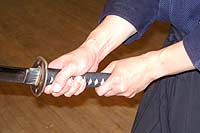 In
a proper grip, the “meat” of the hands is on top of the tsuka
(sword grip). The right hand is always above the left. Single handed techniques
in MSR are always done with the right hand. The right hand is approximately
1” from the tsuba (guard). The left hand wraps about the end of
the tsuka. The little finger of the left hand is wrapped at the end of
the tsuka, not below it. The small and ring fingers of both hands grip
more tightly than the rest of the fingers. There should be no “white
knuckle” effect. In
a proper grip, the “meat” of the hands is on top of the tsuka
(sword grip). The right hand is always above the left. Single handed techniques
in MSR are always done with the right hand. The right hand is approximately
1” from the tsuba (guard). The left hand wraps about the end of
the tsuka. The little finger of the left hand is wrapped at the end of
the tsuka, not below it. The small and ring fingers of both hands grip
more tightly than the rest of the fingers. There should be no “white
knuckle” effect.
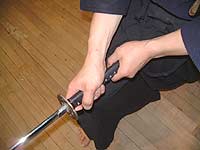 Holding
the sword such that the thumb and first fingers form sort of a v-shape
on top of the tsuka assures a good grip for the round cuts that
are illustrative of the style. As the cut is finished, the iaidoka
(a student of iaido) “wrings” his or her hands over
the top of the tsuka. This method creates power in, and control,
over the cut. Holding
the sword such that the thumb and first fingers form sort of a v-shape
on top of the tsuka assures a good grip for the round cuts that
are illustrative of the style. As the cut is finished, the iaidoka
(a student of iaido) “wrings” his or her hands over
the top of the tsuka. This method creates power in, and control,
over the cut.
|
Cuts
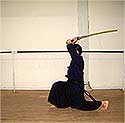 |
(Click on this image to see the
complete sequence) |
Cuts in MSR are done using this “wringing” method mentioned
above. They are round in shape, meaning that the tip of the sword always
leads the cut. The right hand leads the cut while the left provides support.
The last one-quarter of the blade from the tip down is where the cut takes
place. We do not cut with the middle of the blade. This method allows
the tip of the sword to achieve maximum speed in the cut. It also allows
for maximum distance from the target, a consideration in a hypothetical
encounter with a similarly-armed opponent.
Sayabiki
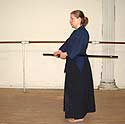 |
(Click on this image to see the
complete sequence) |
MSR includes throughout a technique called "sayabiki." The
sword is seated in the obi such that the tsuba is in the center of the
waist.
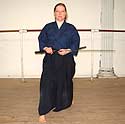 |
(Click on this image to see the
complete sequence) |
Sayabiki means that as the iaidoka is drawing the sword out of the saya
(scabbard) with his right hand, the left hand turns the saya flat and
pulls it back and around the waist. To return the sword to the saya, the
practitioner begins with the sayaguchi (scabbard mouth) at the front center
of his waist, aligns the sword, and pulls the saya back once again with
the left hand (the sword stays balanced on the left hand the entire time).
Eventually, enough room is created to allow the tip of the sword to drop
into the sayaguchi. The iaidoka presses the saya slightly in toward the
waist to allow the tip to drop in properly and allows the sword to slowly
move into the saya. While this technique underlines some aesthetic concepts
that relate to Muso Shinden ryu which will be dealt with in another essay,
on a practical level, sayabiki allows the iaidoka to handle a very long
katana (sword). An old film of Nakayama Hakudo shows him easily handling
a katana that is very long in relation to his overall height using this
method. At New York Budokai, we tend to ignore recommendations of sword
length offered in catalogs and tell new members to simply get an iaito
(iaido practice sword) that is as long as possible without being too heavy
for them.
Interestingly, sayabiki is also preserved in the much older style of
Tamiya ryu iaijutsu (which dates from the late 16th century). We do not
know whether sayabiki existed in the Shimomura ha; but we can say Hakudo
did not "invent" sayabiki as a characteristic of MSR. The technique
already existed.
Omori Ryu Characteristics
MSR iaido, like many other styles, is divided into shoden, chuden and
okuden groups of kata to facilitate learning. It is the shoden level of
Omori ryu which interests us here.
All of the Omori ryu kata save one begin from the kneeling position of
seiza. Seiza is a formal kneeling posture, in which the iaidoka sits on
the floor with the tops of the feet flat behind him. The buttocks touch
the heels. Critics of iaido are fond of pointing out that drawing a long
sword from seiza is a pretty unlikely in actual combat. Most likely, if
one were sitting in this way, he would be indoors and hence not likely
to be in possession of a katana, or long sword (probably only a wakizashi
, a short sword or tanto, a knife). Taylor and Ohmi writing in the Journal
of Asian Martial Arts on the history of the style (1) wisely point out
that seiza is a useful posture for training the quadriceps and lower back.
Moving from seiza allows the beginning student's muscles to strengthen
and gain control, essential work for learning how to move with a long
sword (1997, 86).
As I have mentioned elsewhere, seiza is not only a training tool, it
is a formal posture. A beginning student learning a traditional art form,
such as sado (tea ceremony), kado (flower arranging), or many other traditional
arts, would also be trained in the posture as a matter of course. Learning
manners is part of what the shoden forms teach.
One of the differences in the seiza used for the shoden forms, however,
is that the iaidoka does not "rest" her weight on her heels.
By keeping her quads slightly activated, she can rise from that position
more easily and gracefully than she could otherwise. Keeping the quads
active also improves posture and strength generally.
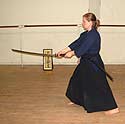 As
to posture, for the most part in all of Muso Shinden Ryu, with only
rare exception, the back must be kept straight, with the iaidoka
leaning neither forward nor backward. Weight is centered at all
times throughout the execution of the forms. As
to posture, for the most part in all of Muso Shinden Ryu, with only
rare exception, the back must be kept straight, with the iaidoka
leaning neither forward nor backward. Weight is centered at all
times throughout the execution of the forms.
|
It takes approximately six months for a beginner to learn to sit in seiza
properly and begin to move with control from that position. For some persons
it may take longer. As a teacher, I get tired of hearing new students
say they "can't" take up this posture; in that case, they "can't"
do iaido either. Practicing seiza during a commercial break once a day
watching TV is often all it takes to stretch everything to accommodate
the posture, given some time.
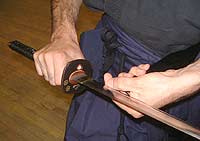 The
noto (resheathing the sword) for all the kata in Omori ryu starts
from the habaki, the copper or brass end piece at the end of the
blade closest to the tsuba (sword guard). This requires the student
to use the full method of sayabiki in order to replace the sword
in the saya. Doing the full technique allows the teacher to acquaint
the new student with the proper method from the very beginning,
and is very good training. The
noto (resheathing the sword) for all the kata in Omori ryu starts
from the habaki, the copper or brass end piece at the end of the
blade closest to the tsuba (sword guard). This requires the student
to use the full method of sayabiki in order to replace the sword
in the saya. Doing the full technique allows the teacher to acquaint
the new student with the proper method from the very beginning,
and is very good training.
|
There are 12 kata in the MSR Omori set. The arrangement of the kata in
the set can vary. The arrangement listed below reflects how we practice
at New York Budokai. Other dojo's practices may be different, though all
of the forms would be included:
Shohatto
Uto
Sato
Atarito
Inyoshintai
Ryuto
Junto
Gyakuto
Seichuto
Koranto
Gyakute-inyoshintai
Batto (also called Nukiuchi)
We will discuss the individual forms in depth in subsequent essays.
Acknowledgements:
The author wishes to thank members of New York Budokai
for their assistance in the preparation of this article.
Photos of New York Budokai members by Danton Mayorga
and Stanley Chin, Copyright 2002 New York Budokai.
Calligraphy by Deborah Klens-Bigman, Ph.D.
Footnote:
(1) (Taylor and Ohmi 1997, 82-84). For more detailed
information on the history of Omori ryu see Taylor, Kimberley and Ohmi
Goyo 1997: “The Omori ryu: a history and explanation” Journal
of Asian Martial Arts Vol. 6 No. 1 pp 80-103.
About The Author:
Deborah Klens-Bigman is Manager and Associate Instructor of iaido at
New York Budokai in New York City. She has also studied, to varying
extents, kendo, jodo (short staff), kyudo (archery) and naginata (halberd).
She received her Ph.D in 1995 from New York University's Department
of Performance Studies where she wrote her dissertation on Japanese
classical dance (Nihon Buyo). and she continues to study Nihon Buyo
with Fujima Nishiki at the Ichifuji-kai Dance Association. Her article
on the application of performance theory to Japanese martial arts appeared
in the Journal of Asian Martial Arts in the summer of 1999. She is married
to artist Vernon Bigman. For FightingArts.com she is Associate Editor
for Japanese Culture/Sword Arts.
|